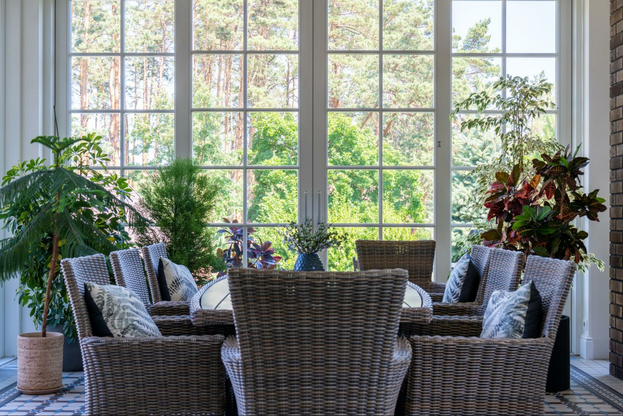
Windows are a gateway between your interior sanctuary and the outside world, providing natural light, ventilation and glimpses of the surrounding landscape. They also contribute to your living spaces’ overall aesthetic appeal, energy efficiency and functionality.
By understanding the various types of windows, their materials, styles and features, you will gain the wisdom to navigate the window selection process confidently and clearly.
Understanding Window Types
There are various window types, each offering unique benefits and characteristics.
With their classic appeal, double-hung windows allow for top and bottom sashes that can be opened or closed independently, providing versatility in ventilation.
On the other hand, casement windows operate on a hinge and swing open like a door, offering unobstructed views and excellent airflow.
Also, slimline windows have gained popularity in modern design, offering sleek profiles that maximise natural light while maintaining energy efficiency.
You can assess the functionalities, aesthetics and suitability for specific areas of your home by understanding the different window types on the market.
Finding the Right Fit
Every room has unique requirements for natural light, ventilation and aesthetic balance. Assessing the size and proportions of each room will help determine the appropriate window size and placement.
For smaller rooms, you may opt for windows that maximise natural light to create an illusion of spaciousness. In larger areas, strategically placed windows can create focal points while ensuring ample daylight.
It is essential to consider the architectural style of your home and the purpose of each room when assessing window size and proportions. Also, considering privacy needs and external views will contribute to finding the right balance.
Glazing Options
The glazing, or the number of glass layers in a window, directly impacts energy efficiency, insulation and soundproofing capabilities. Here are the standard glazing options:
- Single-pane windows consist of a single layer of glass and are typically less efficient in insulation and noise reduction.
- Double-pane windows, on the other hand, feature two glass layers separated by an insulating airspace, offering improved thermal performance and reduced heat transfer.
- Triple-pane windows take it a step further by incorporating an additional glass layer, providing enhanced insulation and noise reduction benefits.
Style and Design Considerations
Windows play a significant role in defining your home’s overall aesthetic and character. Considering your house’s architectural style and design elements is essential to ensure a harmonious and visually pleasing result.
Whether your home boasts a traditional, modern or eclectic style, there are window options to match. Traditional homes often feature double-hung or casement windows with elegant grids, while contemporary designs embrace large, expansive windows for a seamless indoor-outdoor connection.
Soundproofing Solutions
External noise, such as traffic, construction or neighbourhood activities, can significantly disturb your home. When choosing windows, opting for features that minimise noise transmission is crucial.
Windows with double or triple-pane glass and an insulating gas fill in between offer effective soundproofing capabilities. Additionally, selecting windows with proper weather stripping and tight seals can further reduce noise infiltration.
Laminated glass windows with an interlayer provide an additional sound barrier and can be particularly beneficial in noisy areas.
Energy Efficiency
Windows significantly affect heat gain and loss, affecting your home’s overall energy consumption. Choosing windows with excellent insulation properties can reduce your reliance on heating and cooling systems, resulting in lower energy bills and a smaller environmental footprint.
Look for windows with double or triple-pane glass, as they provide enhanced thermal performance and reduce heat transfer. Also, windows with low-emissivity (Low-E) coatings can reflect heat into the room during winter while minimising heat gain during summer.
Properly insulated window frames, such as those made from vinyl, fibreglass or wood with thermal breaks, also contribute to energy efficiency. Investing in energy-efficient windows benefits your wallet and creates a comfortable and sustainable living environment.
Natural Light Enhancement
Embracing natural light in your home brings numerous benefits, from creating a warm and inviting atmosphere to reducing the need for artificial lighting during the day. When selecting windows, prioritise designs that allow ample sunlight to filter in.
Consider more oversized windows, such as floor-to-ceiling or picture windows, to maximise the amount of natural light entering your living spaces. Opt for window styles with minimal obstructions, like casement or awning windows, which provide unobstructed views and allow abundant sunlight to flood the room.
Also, choose window treatments that allow for light control, such as sheer curtains or blinds, enabling you to adjust the amount of sunlight entering the space according to your preference.
In conclusion, choosing the perfect windows for your home is a multifaceted endeavour that requires careful consideration of various factors. From understanding different window types and their functionalities to assessing the size, placement and proportions that suit each room, every decision contributes to the overall aesthetic appeal, energy efficiency and functionality of your living spaces.
Ref: 3394.29772




 POSTED BY
POSTED BY 

